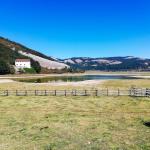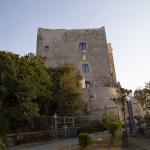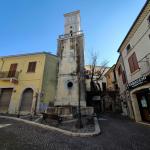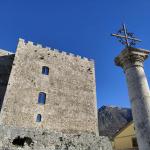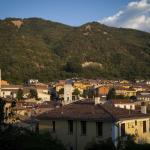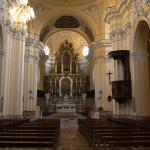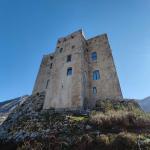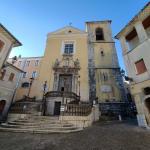The Municipality of Bagnoli Irpino rises in the area of the Picentini Mountains Regional Park. It's a town with 3,139 inhabitants, located 654 metres above sea level, at 40 km from Avellino. The territory extends for 68.81 sq km and the adjoining municipalities are: Acerno, Calabritto, Caposele, Lioni, Montella and Nusco. It's crossed by the river Calore and has several springs.
The etymology of the name seems to come from baniolum, Latin term that indicates the abundance of waters in its territory. The inhabitants are called Bagnolesi and Saint Lawrence is their patron saint.
PLACES ON INTEREST
- Laceno plateau - Extraordinary naturalistic area, located in the Picentini Mountain Regional Park, characterized by a lake of karst origin, a ski area (inactive since 2017), various hiking trails and various outdoor activities, as well as many hotels and refreshment points
- Collegiate of Santa Maria Assunta (Saint Mary of the Assumption) - The Mother Church is located in the heart of the historic centre and can be dated to around the 11th century, even if it had to overcome the terrible fire of 1651: inside, there are interesting paintings, a splendid wooden choir and an admirable baptistery
- Giudeca - It's located behind the Duomo, in the historic centre, and it's the first settlement of Bagnoli Irpino, characterized by many typical alleys: the name derives from settlers of Jewish origin who, first, inhabited it
- Cavaniglia Castle - It's an imposing and robust quadrangular construction with a Norman structure, probably dating back to the 7th-8th century and built with clear defensive purposes
- Historic Palace and Picture Gallery - Built around 1500 by the will of the Cavaniglia Counts, it was born in order to set up a dyeing plant for the textile industry; today, the works of the artists Michele Lenzi and Achille Martelli are preserved
- Town Hall - Dating back to the 17th century and known with the name "Conservatory of Santa Caterina da Siena", it has hosted several educational functions in the past
- Church of San Domenico (Saint Dominic) - Dominated by the majestic 30-meter bell tower, it was erected in 1490
- Civic Tower and Gavitone Fountain - Fountain of the year 1400 approx., built at the centre of the town, surmounted two centuries later by a clock tower and an extraordinary hornbeam plant about 300 years old
- Other churches - Church of S. Giuseppe (Saint Joseph), Church of S. Lorenzo (Saint Lawrence), Church of S. Margherita (Saint Margaret)
- Caves - Caliendo Cave, Santa Nesta Cave
- Springs - Acqualeggia, Muliniello, Tronola
EVENTS
- Festival of the Chestnut and the Black Truffle - Historic food and wine initiative to promote and enhance local products, starting with black truffles and chestnuts: the event takes place between October and November and has grown over the years, setting new records in each edition, reaching national prominence
- Santa Nesta - Procession that takes place on the Monday following Pentecost, in which the statue of Our Lady of Sorrows is carried to Laceno in the procession
- Feast of Saint Lawrence - Religious feast dedicated to the patron saint, with the traditional procession to the district of the same name, where the religious function is celebrated and there is a spectacle of fireworks
- Feast of Saint Roch and Vacca di Fuoco - Two-day celebrations: first the procession with the statue of the saint through the town and then the event of the "vacca di fuoco" (fire cow), a papier-mâché representation of the animal that is lit in the central square
TYPICAL FOOD AND PRODUCTS
- Black truffle of Bagnoli Irpino PAT - Appreciated for its unmistakable flavour and aroma, it's characterized by a black rind with little raised sculptures, called verruche, and by the pulp with white-greyish veins
- Montella Chestnut PGI - Product with white pulp seed, crunchy and with a pleasant sweet taste. It has a long shelf life, high quality flavour and fragrance and is considered among the best chestnuts produced in Italy
- Pecorino bagnolese PAT - Fat and hard cheese, straw-yellow in colour and with an intense taste from the milk of Bagnolese sheep, raised on uncontaminated pastures
- Ricotta di pecora bagnolese PAT - Product of ancient tradition, coming from sheep of the breed called "bagnolese or malvizza", constantly grazing
- Nnoglia di maiale PAT - Also called "doglia", it's mainly used for the preparation of the minestra maritata and, on Easter day, for the preparation of wild chicory soup
- Caciocavallo podolico dei Monti Picentini PAT - Tasty and rare cheese aged up to 6 months, raw, hard and spun paste, particularly valuable
- Caciocavallo irpino di grotta PAT - Spun curd cheese, produced with milk from small and medium-sized farms, mainly from brown cattle, traditionally aged in caves
- Tabacchini Beans PAT - These beans take their name from their colour, light brown: with a strong and characteristic taste, they are particularly suitable for the preparation of soups
- Black truffle liquor PAT - This black truffle liquor has a strong aromatic taste and an alcohol content of 38-40°
- Chestnut nougat PAT - Also called chestnut "pantorrone" o "spantorrone", it's a specialty that has been produced for over 30 years in areas renowned for the cultivation of chestnuts
- Ricotta manteca di Montella PAT - With a cylindrical form and stray yellow colour, it has a soft, delicate and buttery texture: a very good food due its organoleptic characteristics
- Scamorza of Montella PAT - Cylindrical in shape, it's distinguished by the head that looks like a "baby": it has a sweet taste and a strong smell of milk and fresh butter
- Treccia di Montella PAT - Fresh stretched curd cheese, with a characteristic shape of three hand-woven cords and which can also be smoked
- Caciocavallo Silano PDO - Semi-hard cheese, with spun curd, produced with milk from different breeds of cows, including Podolica
FUN FACTS
Bagnoli Irpino was defined "the small Florence of Irpinia" by O. Ruotolo in 1958.
The custom of hanging red peppers to dry them is very characteristic. The peppers, in fact, are "sewn" together with a needle and cotton thread and hung from the balconies, windows and walls in front of the house, colouring the alleys and making them even more characteristic and Mediterranean.
HISTORICAL NOTES
Bagnoli Irpino arose before the year 1000, as a fortified centre in defence of the Lombard Duchy of Salerno. Dipold, Count of Acerra made it a centre of strategic importance: the town became a parade ground, surrounded by mighty walls and equipped with a formidable castle, located on the hill called Serra, and dominating the entire upper Calore Valley.
For centuries it was a Royal Property, until, in the Aragonese period, it was given as a fief, together with Montella and Cassano Irpino, to the Cavaniglia family, Spaniards related to the Orsini.
Erected as a duchy in 1611, it became a fief of the Maiorca-Strozzi family until 1806, the year of the abolition of feudalism.
Who said it's possible to live fantastic adventures only on the other side of the world? A weekend on the Laceno plateau in Bagnoli Irpino among nature trails, flavours and relaxation is ideal for those who love days full of outdoor activities, dedicated to everyone, both experts and non-experts
Bagnoli Irpino
Via Roma, 19, 83043 Bagnoli Irpino AV, Italia
Events
The Alpine and Speleological Rescue of Campania has chosen the Laceno Plateau from the two…
-
On Saturday 20th and Sunday 21st January the program will give free rein to the typically…
Saturday 27 January a unique twilight-evening experience suitable for practically everyone
-
Saturday 3rd and Sunday 4th February the hiking experience along the Tannera gorges. Thrilling…
On Saturday 3 February we will climb Cervialto from its gentler side, passing through Colle…
Tuesday 13 February lots of fun for children with a costume parade, themed games, cotton candy…
Featured places
Località Laceno, 83043 Bagnoli Irpino AV, Italia
An impressive nature area with riding stables and hiking trails, this is a popular destination…
Piazza Umberto I, 19, 83043 Bagnoli Irpino AV, Italia
The numerous works of art and the spectacular wooden body make this church, located in the…
Via D'Asti, 83043 Bagnoli Irpino AV, Italia
A symbol of the integration of the Bagnolese and Jewish communities that settled there, with…
Did you like it? Leave a review
Your opinion is important! It will be visible after approval by the editorial staff.
To post a comment you must be an authenticated user. Log in with Social Login
